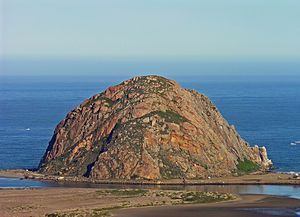Crazifornia: Three ‘crappy’ regulatory battles
By Laer Pearce
For a lot of very good reasons, California’s environmental regulators have earned a reputation for being, well, crappy to the rest of us. Three ongoing California regulatory battles over poop reinforce their already well-deserved reputation.
The first battle is between the California Coastal Commission and the city of Morro Bay over the city’s proposed new wastewater treatment plant. The city, called by some the Gibraltar of the Pacific because the massive Morro Rock dominates its harbor, made the terrible mistake of wanting to do the right thing. It, along with the Cayucos Community Services District, wants to replace an aging wastewater treatment plant with a new facility that will clean wastewater to higher levels and produce recycled water.
Less pollution going into the ocean and less fresh water used to water yards seem like good ideas — except to the California Coastal Commission. The commission’s executive director, Charles Lester, has decided coastal towns should move their unsightly infrastructure away from the coast to inland locations. There’s one little problem with this idea: It defies gravity.
Sewage treatment plants are located at the low point of local geography — the coast in California — because it’s much cheaper to let the sewage flow by gravity to the plant than it is to pump it uphill to an inland plant. In Morro Bay, the commission’s staff, on its own, found a site about one mile from the coast, then decreed that site to be the superior location for wastewater treatment. It is recommending the commission force the city to build the plant there.
If the eco-bureaucrats prevail, they will turn the three-year project into a 10-year one and raise its cost from $60 million to $90 million. They will also saddle Morro Bay’s 10,000 residents with higher bills, since it takes a lot of money — and burns a lot of carbon fuel — to pump sewage uphill. This fact seems to be lost on the commission’s staff, which claims it wants to move infrastructure off the coast not for aesthetic reasons, but because of sea level rise caused by global warming — which in turn is caused, we’re told, by burning a lot of carbon fuel.
The matter was on the commission’s October agenda, but staff pulled it when the city pointed out major inaccuracies and flawed assumptions in the staff’s report.
Cormorant poop
Then there’s the battle over cormorant, pelican and sea gull poop that’s piling up on the rocks in the tony San Diego coastal enclave of La Jolla. Scenic, rocky La Jolla Cove has become an open cesspool, resident Ed Witt told the U-T San Diego, adding, “You couldn’t operate a zoo like this.” The problem started when much of La Jolla’s rocky shore was put off limits to humans, encouraging birds to flock to the rocks, relieving themselves with impressive regularity.
So why not just wash off the poop? That would be fine, regulators at the Coastal Commission and San Diego Regional Water Quality Control Board say. But only if the city submits a plan describing every detail of how they’ll do it — what methods and materials they’ll use, how they’ll protect the ocean and how they’ll ensure pooping pelicans and cruddy cormorants aren’t bothered.
If the clean-up plan poses any perceived threat to birds or marine life, then the California Department of Fish & Game, the U.S. Fish & Wildlife Service and the National Marine Fisheries Service stand poised to join the battle.
It’s not even possible to create a timeline for reaching a solution to this monumental problem, since the Regional Water Quality Control Board has deemed it a low priority. Residents and business owners, who fear the smell will drive away tourists, disagree.
Home invasion
San Diego’s Regional Water Quality Control Board — which I fought unsuccessfully when it decreed that rainwater becomes toxic the moment it hits the ground — is the cause of the third poop battle as well.
Because it succeeded in defining fallen rain as toxic, the board now exerts its authority beyond the prior limits of its purview, the gutter, and reaches into people’s yards. This change is reflected in proposed new regulations that would subject homeowners to six years in prison and fines of $100,000 a day if they repeatedly let dog poop sit unpicked up in their own backyards.
Similar punishments would be meted out to those who repeatedly allow their sprinklers to hit the pavement and those who wash their car in their driveway.
The board’s goal is to cut the amount of bacteria in runoff that reaches the ocean. That reminded me of a study conducted some years ago — in Morro Bay, interestingly enough. Scientists collected samples of ocean water and isolated the DNA from fecal coliform found in it to trace its source. They found it to be overwhelmingly not pet or human in origin, but the DNA of coyotes, rabbits, deer, seals, sea birds and fish.
What will California’s regulators come up with next? Diapers for dolphins?
Laer Pearce, a 30-year veteran of California public affairs, is the author of Crazifornia: Tales from the Tarnished State.
Related Articles
Lawsuit challenges chemical safety regs
California’s ongoing battle over new regulations has an interesting twist: a chemical company is asking a judge to keep in
Sick leave bill could kill jobs, cut hours
An Assembly bill requiring employers to provide paid sick leave could result in nearly a million California workers either
$2 Billion Solar Rebates Program Broke
APRIL 6, 2011 By KATY GRIMES California legislators are pushing a bill through the system for a bankrupt solar subsidy





